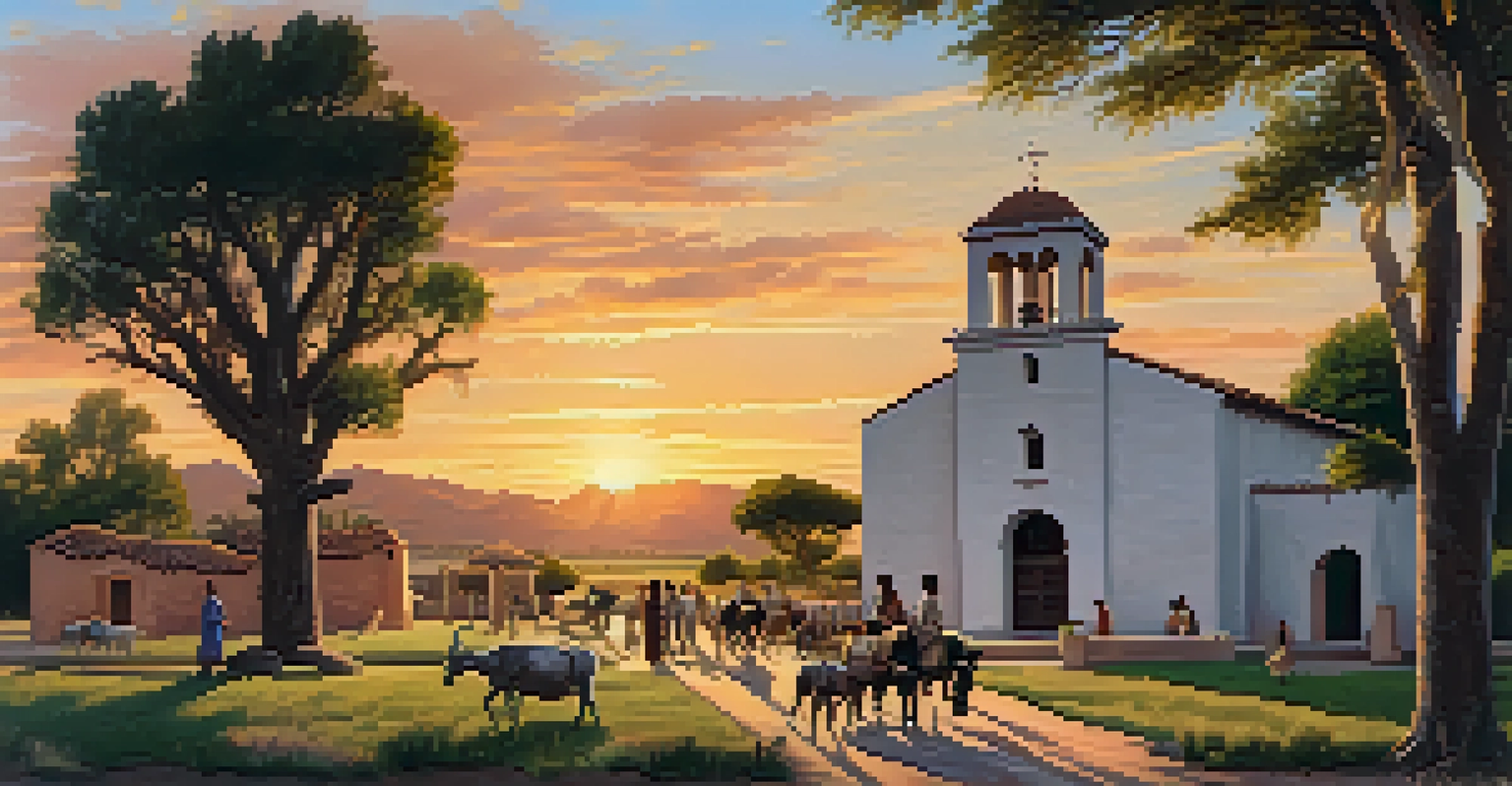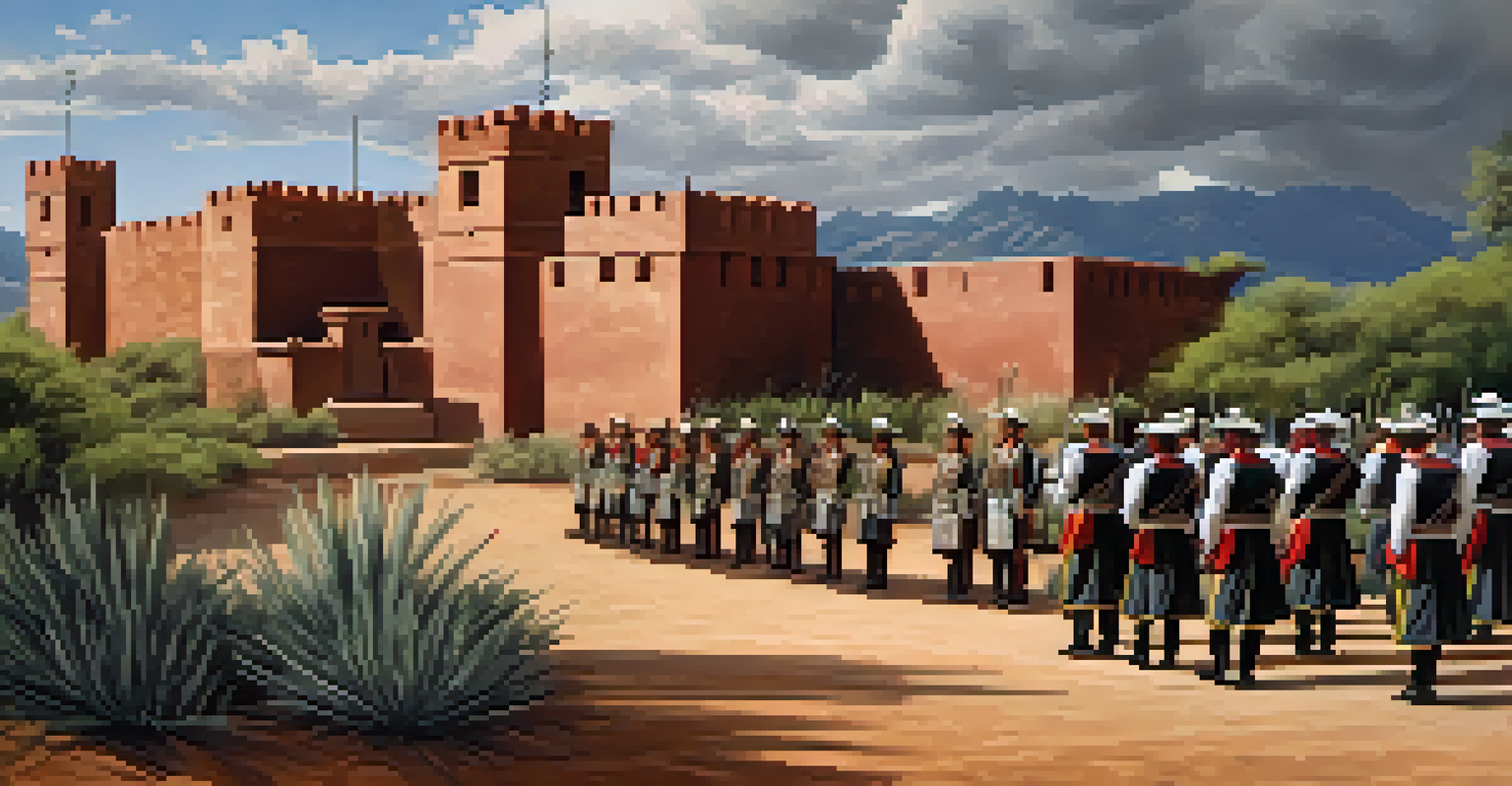Spanish Colonization: The Early European Influence in Texas

The Arrival of Spanish Explorers in Texas
In the early 16th century, Spanish explorers began to set foot in Texas, marking the beginning of significant European influence in the region. Figures like Álvar Núñez Cabeza de Vaca and Hernán Cortés paved the way for later expeditions, documenting their encounters with Native American tribes. Their journeys opened the door to Spanish claims over vast territories, including what we now know as Texas.
The conquest of Texas was not merely a matter of land, but a transformation of cultures and identities.
The exploration wasn’t just about claiming land; it was also about understanding the diverse cultures and landscapes of the area. These explorers often faced challenges such as hostile tribes and harsh environments, which they documented in great detail. Their accounts provided valuable insights into the natural resources and potential for settlement, igniting interest back in Spain.
Ultimately, these early explorations laid the groundwork for future colonization efforts. The Spanish crown recognized the strategic importance of Texas, both for its resources and as a buffer against other European powers. This set the stage for a more permanent presence in the region, leading to the establishment of missions and settlements.
Establishment of Missions: A Cultural Exchange
One of the key components of Spanish colonization in Texas was the establishment of missions. These missions aimed to convert Native Americans to Christianity while also teaching them European agricultural techniques and crafts. This cultural exchange was significant, as it introduced new practices to indigenous communities, sometimes blending their traditions with European customs.

The most famous mission, San Antonio de Padua, was founded in 1718 and became a hub of activity. It was not just a place of worship but also a center for education and trade. Native Americans learned about European farming methods and livestock management, which altered their traditional ways of life.
Spanish Exploration Shaped Texas
Early Spanish explorers documented their encounters, laying the groundwork for future colonization and the establishment of claims over Texas.
However, the mission system was not without its challenges. Many indigenous people resisted conversion and the loss of their cultural identity. This resistance sometimes led to conflicts, highlighting the complexities of the cultural exchange taking place during this period.
The Role of Presidio Forts in Defense and Settlement
Alongside missions, presidio forts were established to protect Spanish settlements and maintain order in the region. These military outposts served as a line of defense against potential threats, including hostile Native American tribes and rival European powers. The presence of presidios helped to solidify Spanish claims over Texas and encouraged further colonization.
In the end, the greatest legacy of Spanish colonization is not just in the land, but in the blending of traditions that continues to shape our identity.
Presidios were often strategically located near missions and settlements, creating a network of support and security. Soldiers stationed at these forts played a crucial role in maintaining peace and facilitating trade between different groups. They acted as mediators, helping to foster communication between Spanish settlers and Native American tribes.
However, the establishment of presidios also led to tensions as the Spanish military presence disrupted traditional ways of life for many indigenous communities. The balance between protection and oppression became a delicate one, shaping the relationships between different cultures in Texas.
Spanish Land Grants and the Growth of Settlements
Land grants were another vital aspect of Spanish colonization, allowing settlers to claim parcels of land for agriculture and ranching. These grants promoted the growth of settlements, as they attracted families seeking new opportunities in the fertile lands of Texas. The promise of land was enticing and led to a surge of Spanish immigration in the 18th century.
Settlers often established farms and ranches, contributing to the region's economy. The introduction of cattle ranching, in particular, became a defining feature of Texas culture. Spanish settlers brought their expertise in livestock management, which eventually evolved into the iconic Texan ranching traditions we know today.
Missions Fostered Cultural Exchange
The establishment of missions in Texas aimed to convert Native Americans while introducing new agricultural methods, creating a blend of traditions.
However, the land grants also sparked conflicts with Native Americans, who viewed these encroachments as a threat to their territories. Tensions escalated as settlers expanded into traditional lands, leading to a complex relationship between the two cultures.
Economic Impact: Trade and Agriculture
The Spanish colonization of Texas had a profound economic impact, particularly through the introduction of new agricultural practices. Crops like wheat, corn, and sugarcane were brought over from Europe, transforming the landscape and diet of the region. This agricultural shift helped to establish a more stable food supply for both settlers and indigenous communities.
Trade routes began to develop as settlements grew, connecting Texas to other Spanish territories. Goods such as cattle, hides, and agricultural products were exchanged, fostering economic interdependence. This trade not only bolstered the local economy but also integrated Texas into the broader Spanish colonial system.
However, the economic changes brought about by colonization also had downsides. Indigenous communities often found themselves marginalized in trade and agriculture, leading to shifts in power dynamics. The economic landscape became increasingly dominated by Spanish interests, often at the expense of native rights.
Cultural Legacy: Language and Traditions
The cultural legacy of Spanish colonization in Texas is still evident today, particularly in the language and traditions that have become integral to Texan identity. Spanish, alongside English, is widely spoken in the region, reflecting the historical influence of colonization. This bilingualism enriches the cultural tapestry of Texas, showcasing a blend of cultures.
Traditional celebrations, such as Cinco de Mayo and Dia de los Muertos, have their roots in Spanish and Mexican heritage. These festivities are not only a way to honor cultural traditions but also serve as a reminder of the region's complex history. They bring people together, fostering a sense of community and shared identity.
Economic Changes Impacted Cultures
Spanish colonization transformed Texas's economy through new agricultural practices and trade, but often marginalized indigenous communities in the process.
Moreover, the culinary landscape of Texas has been significantly shaped by Spanish influence. Dishes like tamales, enchiladas, and tacos highlight the fusion of Native American and Spanish cuisines. This culinary blend is a delicious testament to the enduring impact of colonization on Texas culture.
Challenges and Conflicts: A Complicated History
While Spanish colonization brought many changes to Texas, it also came with significant challenges and conflicts. The imposition of Spanish laws and customs often clashed with the traditions of Native American tribes, leading to resistance and strife. The complexities of these interactions created a turbulent backdrop for Texas’s early history.
Conflicts over land, resources, and cultural differences frequently erupted into violence. Many Native Americans fought to protect their territories from encroaching Spanish settlers, leading to a series of skirmishes and battles. These conflicts were not just territorial; they were deeply rooted in the struggle to preserve cultural identity.

Despite these challenges, the Spanish colonization of Texas set into motion a series of events that would shape the region for centuries to come. The legacies of these conflicts and cultural exchanges continue to resonate in Texas today, reminding us of the complex history that defines this vibrant state.